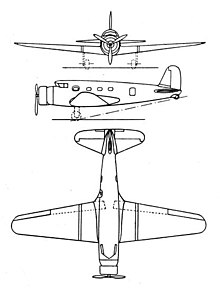Vultee V-1
| Vultee V-1 | |
|---|---|

|
|
| Type: | Airliner , business aircraft |
| Design country: | |
| Manufacturer: | |
| First flight: |
February 19, 1933 |
| Production time: |
1934-1937 |
| Number of pieces: |
27 |
The Vultee V-1 was a single-engine express transport and business jet aircraft made by the US manufacturer Airplane Development Corporation in the 1930s. The production version V-1A could carry two pilots and up to eight passengers. A prototype, two special models and 24 series models were produced from the all-metal aircraft designed as a low-wing aircraft .
history
In 1932 the aircraft designer Gerard Vultee presented the design of a new kind of high-speed airliner made entirely of metal. After receiving great interest from the airlines, he founded the Airplane Development Company . Manufacturing initially took place in Burbank , but was later relocated to Glendale , also in California .
The prototype was used for the operation conducted on 19 February 1933 first flight for extensive flight tests that were completed after a year. The changes made as a result included a wider and longer fuselage, a larger wingspan, the installation of a second pilot's seat and a number of smaller improvements. In July 1934 the revised model V-1A received its approval. In the same month, delivery of eight V-1As and the prototype to American Airlines began .
With the appearance of the twin-engine models Boeing 247 and Douglas DC-2 , which promised greater safety , the airlines lost their interest in the V-1. It was subsequently sold to business people who were impressed by its high speed. One of these planes set a new speed record in 1936 when it traveled from New York to near London in less than 19 hours. A more motorized special version was created for the publisher William Randolph Hearst as the V-1AD. This aircraft was the only one that survived and is now in the Virginia Aviation Museum .
Sixteen aircraft were sold to the two parties in the Spanish Civil War and, after their conversion, served as bombers, transporters and reconnaissance aircraft. Another model with the designation V-1AS was created in 1936 on behalf of the Soviet Union and was designed as a seaplane with twin swimmers.
construction
The outer skin of the aircraft consisted of individual strips of riveted aluminum sheet, which could easily be replaced if damaged. The V-1 had a retractable tail wheel landing gear . A Wright Cyclone radial engine with a three-blade propeller served as the drive . The availability of new engine variants increased the output from 560 kW in the first series models to 735 kW in the V-1AD.
The prototype only had one pilot's seat. At the request of the airlines, the series models were given a two-man cockpit. The cabin had an oval cross-section and was designed for eight people.
Technical specifications
| Parameter | Vultee V-1A |
|---|---|
| crew | 2 |
| Passengers | 8th |
| length | 11.30 m |
| span | 15.20 m |
| height | 3.10 m |
| payload | 1410 kg |
| Empty mass | 2440 kg |
| Takeoff mass | 3850 kg |
| Cruising speed | 330 km / h |
| Top speed | 360 km / h |
| Service ceiling | 6100 m |
| Range | 1900 km |
| Engines | a 9-cylinder radial engine Wright Cyclone R-1820-F2 with 560 kW |
